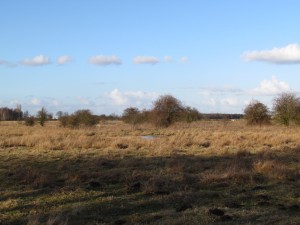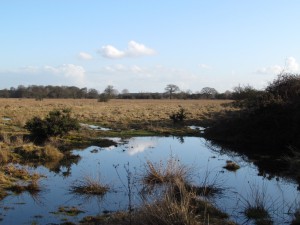Heslington Tillmire SSSI
Heslington Tillmire Site of Special Scientific Interest is about 40ha of unimproved , wet grassland, situated roughly 3km south of Heslington Village (grid reference for the center of the site SE637475). It has good populations of breeding waders, but is rather poorly covered by local birders, although rather more than usual visited it in early 2015 to see a wintering Great-grey Shrike.
Habitats
The unimproved grassland is crisscrossed by shallow ditches and the northern and western areas in particular flood in the winter. More-or-less in the middle is a decent sized pond. There are patches of hawthorn scrub in several places, and good old boundary hedges and trees. Parts of the grassland are mown, and the whole area is grazed by cattle and sheep.
Bird Life

Four species of waders breed regularly (in decreasing order of abundance, Lapwing, Snipe, Redshank and Curlew), with Lapwings and Curlews also breeding on adjacent farmland. Other breeding species of note include Meadow Pipits, Skylarks and Reed Buntings. Teal winter (and may breed). Barn Owls regularly hunt over the area (and breed nearby), as do Kestrels and Buzzards. Merlins are occasional in winter. The old boundary hedges and hawthorn scrub have good populations of breeding Willow Warblers, Chiffchaffs, Blackcaps and (less predictably) Garden Warblers, and this is a good place to see species that can be difficult to find on the Vale of York, including Willow Tits, Jays, Green Woodpeckers and Little Owls. Flocks of wintering Redwings and Fieldfares are common. The deep, wide Tillmire Drain that runs along part of the south-eastern boundary is worth checking for wintering Green Sandpipers and Kingfishers.

Other Wildlife
The northern third of the site is the wettest and the most interesting botanically, and although there are no national rarities several plants that are generally scarce on the Vale of York occur here.
Access
The Tillmire is Open Access Land, and there are also public rights of way along its western, northern and eastern boundaries. Most of the birds can be found by sticking to the edges.
It is not an easy site to get to. It is possible to drive (or cycle) to the eastern corner, with limited parking on the verge at Fir Tree Farm (SE646472); to get here go down Heslington Main Street, turn right at the T-junction and follow Common Lane for about a mile; go over the bypass (A64) (where the road you are on changes its name to Long Lane) and after another mile reach a second T-junction and turn right on to Langwith Stray; it’s then another mile to Fir Tree Farm.
Alternatively you can cycle or walk the 2 miles to the Tillmire from Fulford Golf Course on a public bridleway (only golf-club members can drive down this road); after going over the bypass here you can turn either right or left on public footpaths to go down the eastern or western boundaries of the golf course to reach the Tillmire.
By John Lawton, September 2015
